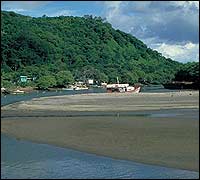At dawn, after pushing to the back of your mind images of the snake the locals call Silent Death, you start hiking. All day, as you head toward that evening’s campsite, you follow a trail that leads through rainforest where big cats hide. Later it moves out onto wave-pummeled beaches where, if you haven’t read the tide tables, you’ll find yourself pinned against a cliff by incoming water. Finally, if your luck has held, you hoist your pack above your head and wade across the mouth of a muddy, swirling jungle river, keeping a lookout for crocodiles cruising downstream and sharks cruising up. And this, you remind yourself as something bangs against your submerged leg—a snake? a croc? a harmless branch?—is in Costa Rica, the country that is supposed to have become tame and civilized.
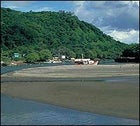
Of course, parts of Costa Rica have become overdomesticated. Large sections of the country now cater to mainstream tourists searching for packaged “adventure” travel. In some areas, new hotel rooms outnumber insect species, and the crush of visitors at the most popular national parks is so great that wildlife sightings have become rare. If you want a photo of a quetzal, you may have to settle for those in the visitor center postcard display.
But the old Costa Rica, a country of unspoiled rainforest, abundant wildlife, rustic facilities, and bracing physical discomfort, does still exist. It lies only 90 miles southwest of San José on the Pacific coast’s rugged Osa Peninsula.
The Osa, much of which is occupied by the 160-square-mile Corcovado National Park, is a more biologically rich area than even Times Square on New Year’s Eve. Known for jaguars and other big cats, the peninsula is home to hundreds of species of birds as well, including one of the largest populations of scarlet macaws in Central America. It also sports a variety of reptiles and thousands of kinds of insects, many available for viewing in your bathroom at night. What the Osa lacks are legions of other tourists: The hard travel necessary to reach the area discourages all but the hardy and self-sufficient.
The Osa does have some basic comforts, of course. A few rutted dirt roads crisscross the area (a four-wheel-drive vehicle is essential), and pleasant lodges dot the landscape. Pitching your own tent is necessary only if you’ve arrived with a circus. As a bonus, the owners of these lodges can usually arrange horseback rides, guided hikes, sea kayaking, sport fishing, or scuba dives. Most important, they know when the tides come in and where the snakes gather. Listen to them.
Corcovado National Park
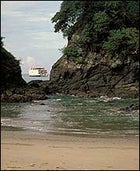
Situated 11 miles south of Drake Bay, heavily forested Corcovado is so rugged that to this day it remains roadless. That makes it a perfect park for hikers, especially if they don’t mind getting hot under the collar. Temperatures here routinely soar into the nineties.
Corcovado’s main trail, and its most scenic, is the 25-mile coastal walk. For part of its length it hugs the beach, where you’ll see turtle tracks in the sand, monkeys in the trees, and great gaudy flocks of scarlet macaws winging overhead. Before setting out, be sure to check the tide tables (every lodge has a set) so you don’t get trapped when a beach covers or a river becomes too deep to wade. Watch the weather as well. If it has been raining hard, some rivers may become impassable. And if you decide to cool off in the ocean, beware of riptides or you may suddenly find yourself halfway to Hawaii.
The coast walk has two trailheads, depending on whether you access it from the north end of Corcovado or the south. San Pedrillo, just south of Drake Bay, is at the northernmost end; La Leona is at the southern starting point. You must check in with the ranger station at either trailhead, and you need a reservation, which can be made in advance through the national park headquarters in San Jos‹ (011-506-735-5036). Trail fee is $7 in advance, $15 at the station.
From either starting point, you’ll spend the night at Sirena, a ranger station halfway along the trail. Pitch a tent ($2) or sleep beneath the eaves of the station’s roof ($4). With advance notice, the rangers can feed you rice and beans ($16 per day). If your Spanish is passable, stick around for an extra day. You’ll hear some good stories about hikers getting treed by wild pigs. Don’t laugh too heartily, though; the same fate could await you. Angry boars are a common trailside hazard.
At the end of the coastal walk, plan a few days of R&R at Costa Rica Expeditions’s Corcovado Lodge Tent Camp on Playa Carate. The camp’s beachfront setting is one of the most isolated and beautiful in all of Costa Rica (doubles, $67.85 per person, including three meals; phone 257-0766, fax 257-1665). It also has a tree-canopy platform, and if you are absolutely sure you don’t sleepwalk, you can spend the night there, 120 feet up ($125 per person).
Golfo Dulce and Cayo Island
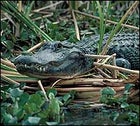
Golfo Dulce
The eastern shore of the Osa Peninsula is bordered by the deep-blue Golfo Dulce, where game fish lurk and some very long waves come to die. Sea kayaks are the best means of exploring the area. The upper gulf’s serrated shoreline is a wilderness made for flatwater cruising, assuming of course that you have no particular phobia about crocodiles. And near the entrance, where the Golfo Dulce and the Pacific clash in the unruly manner so beloved by surfers and big-game fishermen, open-water paddlers will find just about all the excitement they can handle.
Bivouac on the gulf at Puerto Jimñez, a former gold-rush boomtown now filled with laid-back Americans who all seem to have headed south without leaving a forwarding address. Find them—and information about local adventuring—at Restaurante Carolina, where the cold beer starts flowing well before noon. Don’t be concerned by the appearance of intrigue: If a woman leans over to whisper to you conspiratorially that she used to work for the government, she probably means only that she recently lost her job as a postal worker.
Escondido Trex, which has an office near the bar in the Carolina, runs single- and multiday kayak camping trips in the Golfo Dulce. Bring your snorkeling gear and hope for waters calm enough to allow you to shoot through the Matapalo Arch, a curving rock at the southern tip of the peninsula ($85 for an overnight trip, including all meals and gear; phone/fax 735-5210).
San José-based RŒos Tropicales, Costa Rica’s major paddle-sport operator, also offers a Golfo Dulce sea kayaking trip ($1,370 for nine days; 233-6455). North Carolina’s Nantahala Outdoor Center began leading trips to the area two years ago; its ten-day tours mix sea kayaking and inland hiking ($1,475; 704-488-2175).
Not far south of Puerto Jimñez, the Osa Peninsula comes to an end. If you’ve come this far, treat yourself to a night or two at Lapa Rios, 45 minutes south of Jimñez, one of the most upscale lodges anywhere in the Costa Rican rainforest (doubles, $146 per person; 735-5130, fax 735-5179). After some excellent sea kayaking right off the beach or a horseback ride to nearby waterfalls, you’ll want to take advantage of the lodge’s massage service.
Caÿo Island
Rainforest-covered Caÿo Island, 13 miles offshore from Drake Bay, was used as a sacred burial ground by pre-Columbian Indians, who noted—as park rangers do today—that it’s struck by lightning with unusual frequency. A $65 boat trip carries you to this uninhabited island and its centuries-old artifacts—or those that remain. All over the island, depressions in the earth mark graves that were raided years ago. Caÿo’s greatest appeal, however, lies off terra firma and beneath the sea. Though the waters here are not Caribbean-style clear, the marine life is abundant. A snorkeling trip can yield dozens of animal encounters, especially with moray eels and olive ridley turtles. If you’re scuba certified, sign up with dive master Jos‹ Marin, based at the Aguila de Osa, and watch as sharks and manta rays put on a floor show. A two-tank dive costs $110.
Drake Bay and ���ϳԹ��� the Osa
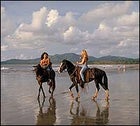
Drake Bay
The Osa’s northernmost point, Drake Bay, a rudimentary town named for Sir Francis, is a good starting place for exploration. With at least seven lodges clustered near the headland, it’s the most developed part of the peninsula. But it’s also pleasantly isolated, with no road or air links to the rest of the Osa—or the world. Visitors must undergo a literal rite of passage: The only way to reach Drake Bay is on a small boat that rips through huge Pacific breakers at the mouth of the Rio Sierpe. This wetting is worth it. Drake Bay is blessed with some of the prettiest scenery and most exotic dive sites in Costa Rica.
To get to the bay, begin at the inland city of Palmar Sur, the inevitable jumping-off point for all tours of the Osa Peninsula. Pause in town long enough to look at the large, pre-Columbian stone spheres in the plaza on the south side of the river. Perfectly round, they are among thousands found all over southwest Costa Rica. Scientists have never determined their origin, though it seems obvious they could only have been bowling balls for the gods.
The tiny village of Sierpe, a slow, bumpy, $15 taxi ride from Palmar Sur, is the staging point for the boat trip to Drake Bay. The trip begins as a scenic ride (about $20), complete with iguanas in the trees and crocodiles along the shore. But 15 miles downriver, just as you’re feeling complacent, you’ll look up and realize you are headed straight into huge, boat-chewing whitewater surf. At that point, the driver will gun the engine, cut back, and gun it again, mentally measuring time and angles as he negotiates walls of crashing water before finally breaking through and speeding the final five miles to Drake Bay. (Though this ride is usually heart-stopping for passengers, at least one of the lodge workers, well accustomed to the drama, will probably sleep the whole time.)
At Drake Bay itself, the most haute-jungle accommodations are at the Aguila de Osa Inn, where the high-peaked rooms and open-air dining area give you a skybox view of comings and goings on the bay (doubles, $100 per person, including meals; phone/fax, 232-7722).
Farther afield, the Mapache Wilderness Camp and Fishing Lodge lies several miles upriver on the Sierpe. Recently built by an Italian couple with a pledge to invest part of the profits in land preservation, the lodge is proudly rustic; its owners seem to be boasting as well as warning when they tell visitors, “Do not forget that many kinds of dangerous snakes and crocodile families live close to the houses.” Rates for doubles are $75 per person in the owners’ house, $45 per person in platform tents. The lodge also runs tours of the Osa. Phone 786-6565, fax 786-6358.
Fun in and around Drake Bay often involves a saddle. Guided horseback rides along the beach can be arranged through most lodges. Be aware, though, that while many horses here are gentle, some answer, appropriately, to names such as Volcano and Stormy.
Once you and your mount have bonded, leave the beach and head up into the rainforest. The clay paths lead to gorgeous lookouts, but canter with caution: The gullies are deep enough to swallow a cavalry.
End a day at Drake Bay with the most high-flying adventure of all: a canopy tour offered by…Canopy Tours. High in the trees, where you’ll share space with monkeys, scarlet macaws, and blue morpho butterflies, you propel your swing chair via a pulley-and-cable arrangement between three penthouse-level viewing platforms ($40 per person; 257-5149).
���ϳԹ��� the Osa
Across the Golfo Dulce, on Costa Rica’s mainland but still on the gulf, the waves break long, strong, and left. For decades, surf aficionados have headed to Pavones to catch these legendary breakers. A ferry runs daily from Puerto Jimñez to Golfito ($5, no cars). From there, buses and water taxis ferry surfers to Pavones.
Fishermen, too, will want to cross to Golfito, since most of the gulf’s sportfishing boats are based there. Try hooking up with Captain Steve Lino at Golfito Sportfishing. His boats actually run out of Zancudo, a beach town just south of Golfito where gringos have built a series of vacation dream shacks. The fishing, for sailfish, marlin, and other game fish, costs $350-$400 per day (phone/fax 382-2716).
Accommodations in Pavones tend toward the primitive, but at least they’re cheap, rarely rising above $20 per night. The Oficina de Servicios Turisticos de Golfito (phone 775-0131, fax 775-0631) can make reservations. For more luxury, check into the Tiskita Jungle Lodge (and fruit farm), four miles south of Pavones (doubles, $75 per person; phone 233-6890, fax 255-4410). It’s so close to the Panama border that visiting the detached bathrooms almost requires a passport.


